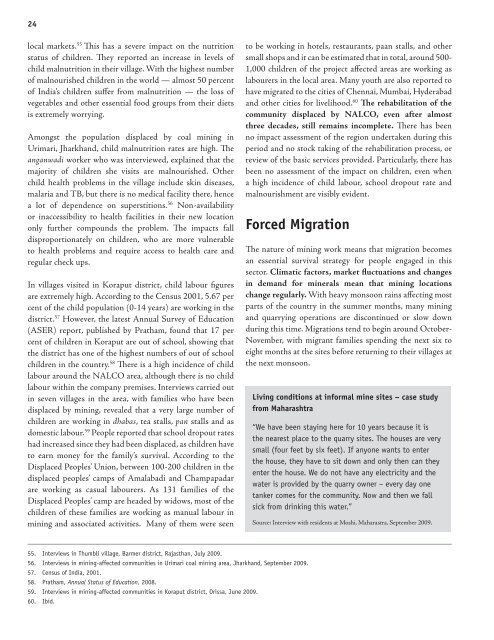Children - Terre des Hommes
Children - Terre des Hommes
Children - Terre des Hommes
You also want an ePaper? Increase the reach of your titles
YUMPU automatically turns print PDFs into web optimized ePapers that Google loves.
24<br />
local markets. 55 This has a severe impact on the nutrition<br />
status of children. They reported an increase in levels of<br />
child malnutrition in their village. With the highest number<br />
of malnourished children in the world — almost 50 percent<br />
of India’s children suffer from malnutrition — the loss of<br />
vegetables and other essential food groups from their diets<br />
is extremely worrying.<br />
Amongst the population displaced by coal mining in<br />
Urimari, Jharkhand, child malnutrition rates are high. The<br />
anganwadi worker who was interviewed, explained that the<br />
majority of children she visits are malnourished. Other<br />
child health problems in the village include skin diseases,<br />
malaria and TB, but there is no medical facility there, hence<br />
a lot of dependence on superstitions. Non-availability<br />
or inaccessibility to health facilities in their new location<br />
only further compounds the problem. The impacts fall<br />
disproportionately on children, who are more vulnerable<br />
to health problems and require access to health care and<br />
regular check ups.<br />
In villages visited in Koraput district, child labour figures<br />
<br />
<br />
district. However, the latest Annual Survey of Education<br />
<br />
cent of children in Koraput are out of school, showing that<br />
the district has one of the highest numbers of out of school<br />
children in the country. 58 There is a high incidence of child<br />
labour around the NALCO area, although there is no child<br />
labour within the company premises. Interviews carried out<br />
in seven villages in the area, with families who have been<br />
displaced by mining, revealed that a very large number of<br />
children are working in dhabas, tea stalls, pan stalls and as<br />
domestic labour. People reported that school dropout rates<br />
had increased since they had been displaced, as children have<br />
to earn money for the family’s survival. According to the<br />
Displaced Peoples’ Union, between 100-200 children in the<br />
displaced peoples’ camps of Amalabadi and Champapadar<br />
are working as casual labourers. As 131 families of the<br />
Displaced Peoples’ camp are headed by widows, most of the<br />
children of these families are working as manual labour in<br />
mining and associated activities. Many of them were seen<br />
to be working in hotels, restaurants, paan stalls, and other<br />
small shops and it can be estimated that in total, around 500-<br />
1,000 children of the project affected areas are working as<br />
labourers in the local area. Many youth are also reported to<br />
have migrated to the cities of Chennai, Mumbai, Hyderabad<br />
and other cities for livelihood. The rehabilitation of the<br />
community displaced by NALCO, even after almost<br />
three deca<strong>des</strong>, still remains incomplete. There has been<br />
no impact assessment of the region undertaken during this<br />
period and no stock taking of the rehabilitation process, or<br />
review of the basic services provided. Particularly, there has<br />
been no assessment of the impact on children, even when<br />
a high incidence of child labour, school dropout rate and<br />
malnourishment are visibly evident.<br />
Forced Migration<br />
The nature of mining work means that migration becomes<br />
an essential survival strategy for people engaged in this<br />
sector. Climatic factors, market fluctuations and changes<br />
in demand for minerals mean that mining locations<br />
change regularly. With heavy monsoon rains affecting most<br />
parts of the country in the summer months, many mining<br />
and quarrying operations are discontinued or slow down<br />
during this time. Migrations tend to begin around October-<br />
November, with migrant families spending the next six to<br />
eight months at the sites before returning to their villages at<br />
the next monsoon.<br />
Living conditions at informal mine sites – case study<br />
from Maharashtra<br />
“We have been staying here for 10 years because it is<br />
the nearest place to the quarry sites. The houses are very<br />
small (four feet by six feet). If anyone wants to enter<br />
the house, they have to sit down and only then can they<br />
enter the house. We do not have any electricity and the<br />
water is provided by the quarry owner – every day one<br />
tanker comes for the community. Now and then we fall<br />
sick from drinking this water.”<br />
.<br />
55.<br />
56.<br />
57.<br />
Interviews in Thumbli village, Barmer district, Rajasthan, July 2009.<br />
Interviews in mining-affected communities in Urimari coal mining area, Jharkhand, September 2009.<br />
Census of India, 2001.<br />
58. Pratham, Annual Status of Education, 2008.<br />
59.<br />
60.<br />
Interviews in mining-affected communities in Koraput district, Orissa, June 2009.<br />
Ibid.






